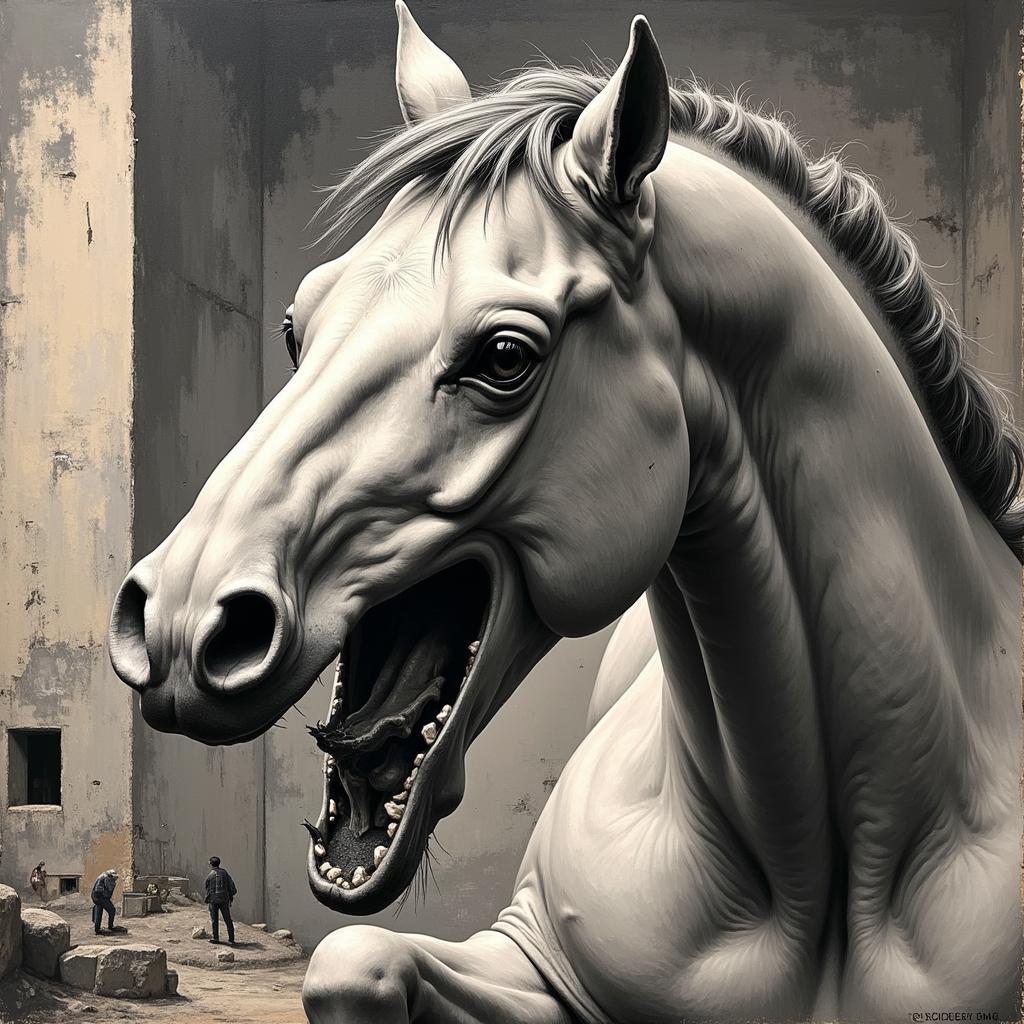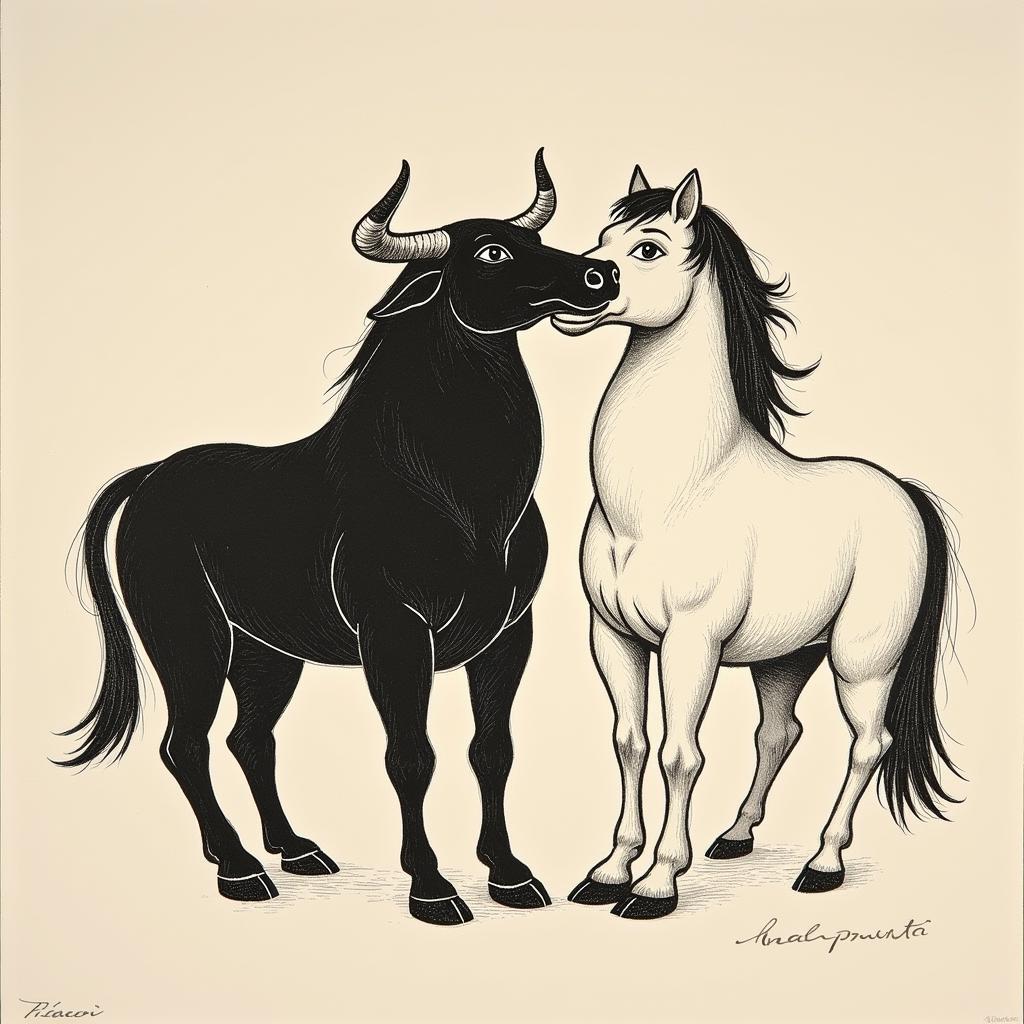Picasso’s fascination with horses is evident throughout his extensive artistic career. From his early realistic depictions to the later abstract and Cubist interpretations, the horse served as a recurring motif, reflecting Picasso’s evolving artistic styles and personal experiences. This article delves into the significance of “Picasso Paintings Horse,” exploring how this majestic animal influenced his work and what these portrayals reveal about the artist himself.
The Horse as a Symbol in Picasso’s Work
Picasso’s use of the horse transcended mere representation. It became a powerful symbol imbued with various meanings. In his early works, horses often represented traditional notions of nobility, strength, and freedom. As his style developed, the horse took on more complex connotations, reflecting the artist’s personal struggles, political commentary, and exploration of form and emotion. For example, the distorted and fragmented horses in his Cubist works can be interpreted as a reflection of the fractured nature of modern society.
Horses also played a significant role in Guernica, arguably Picasso’s most famous work, where a screaming horse symbolizes the suffering and chaos of war. This powerful imagery cemented the horse as a potent symbol in Picasso’s artistic vocabulary.
 Picasso's Guernica Horse: Symbol of Suffering and War
Picasso's Guernica Horse: Symbol of Suffering and War
Later in his career, Picasso’s depictions of horses became more playful and expressive, often imbued with a sense of vitality and dynamic movement. He experimented with different mediums and techniques, capturing the essence of the horse in simplified yet evocative forms. These later works demonstrate Picasso’s mastery of line and form, as he distilled the horse’s essence to its most fundamental elements.
Understanding the Evolution of “Picasso Paintings Horse”
Tracing the evolution of “picasso paintings horse” reveals a fascinating journey through Picasso’s artistic development. His early, realistic portrayals demonstrate a strong grasp of anatomy and traditional techniques. As he moved towards Cubism, the horse became a vehicle for exploring fragmentation, perspective, and the interplay of planes and angles.
 Picasso Blue Period Horse: Melancholy and Empathy
Picasso Blue Period Horse: Melancholy and Empathy
The influence of Surrealism further transformed Picasso’s depiction of horses, introducing dreamlike elements and distorted forms. These changes reflect not only Picasso’s artistic evolution but also the changing cultural and historical context in which he worked.
What Inspired Picasso to Paint Horses?
Picasso’s lifelong fascination with horses stemmed from several sources. From his childhood in Malaga, Spain, where he observed horses in bullfights and everyday life, to his later experiences in Paris, the horse remained a constant presence in his artistic imagination. He was also deeply influenced by the works of other artists, such as El Greco and Goya, who had depicted horses in their own unique styles.
“Horses are more than just animals to me,” a fictional art historian, Dr. Eleanor Vance, specializing in 20th-century art, explains. “They represent a powerful connection to our primal instincts, to freedom, and to the very essence of life itself. Picasso understood this deeply, and he channeled that understanding into his art.”
The Significance of the Bull and the Horse in Picasso’s Art
The bull and the horse often appear together in Picasso’s work, representing a complex interplay of opposing forces. The bull, symbolizing primal energy and aggression, is often juxtaposed with the horse, representing grace, nobility, and vulnerability. This dynamic duo allows Picasso to explore themes of conflict, duality, and the human condition.
 Picasso Bull and Horse Lithograph: Dynamic Interplay of Opposing Forces
Picasso Bull and Horse Lithograph: Dynamic Interplay of Opposing Forces
Conclusion: The Enduring Legacy of “Picasso Paintings Horse”
“Picasso paintings horse” offers a captivating glimpse into the mind of a master artist. From his early realistic portrayals to his later abstract interpretations, the horse remains a powerful and evocative symbol throughout Picasso’s oeuvre. By exploring the various ways in which Picasso depicted this majestic animal, we gain a deeper understanding of his artistic genius, his personal struggles, and his enduring legacy.
FAQ
- What is the significance of the horse in Guernica?
- How did Picasso’s style influence his depiction of horses?
- What other animals frequently appear in Picasso’s work?
- Where can I see Picasso’s horse paintings in person?
- Are there any books or articles specifically about Picasso’s horses?
- How did Picasso’s personal life influence his art, particularly his depictions of horses?
- What is the estimated value of Picasso’s horse paintings?
“The horse represents more than just a subject for Picasso,” adds another fictional expert, renowned art curator, Mr. James Thornton. “It is a window into his soul, a mirror reflecting his emotions, his experiences, and his unique vision of the world.”
Need more help? Contact us at Phone Number: 0772127271, Email: [email protected] or visit our address: QGM2+WX2, Vị Trung, Vị Thuỷ, Hậu Giang, Việt Nam. We have a 24/7 customer support team. We also have other helpful articles on our website concerning horse care and other pet-related information. Consider checking out our resources on horse breeds, training tips, and health advice.